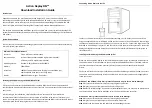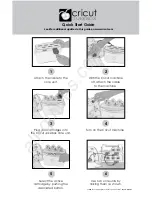
8
3. Battery Cabinet Installation
3.7 Electrical Connection
DANGER! LETHAL HIGH VOLTAGE HAZARD!
All wiring should be performed by a qualified electrician, in accordance with the warnings in this manual and all
applicable electrical and safety codes. Incorrect wiring may cause serious personal injury and property damage.
• The battery cabinet is to be connected to the load through a DC circuit breaker. This allows the battery to be disconnected from the load
and charger for maintenance and/or repair.
• The DC molded case circuit breakers are UL-listed for branch circuit protection. If replacement is required, UL-listed components with the
same voltage and current rating must be used.
• The size of the load connection cables must consider maximum allowable voltage drop as well as the cables’ continuous ampere capacity
and anticipated ampere discharge rate of the individual battery cabinet. A maximum voltage drop of 1.5 VDC in the load connection
cables is recommended. Refer to the UPS unit’s Owner’s Manual for recommended wire sizes.
• Refer to all applicable local, state and national codes (including NEC) for appropriate cable size and ratings.
• External circuit protection devices (fuses or circuit breakers) must consider the discharge rate of the battery, the wiring to be protected and
the DC short circuit current of the battery.
• If the battery cabinet includes an integrated battery charger (single-phase and “C” models only), the charger input must be connected to
an AC supply circuit separate from the UPS system.
1. Open the front door of the battery cabinet to access internal components. Use a digital voltmeter when voltage measurements are
required.
2. Determine if the battery has been inadvertently grounded by resetting the circuit breaker to the “on” position and measuring the voltage
between the battery cabinet grounding lug and the positive load connection point within the cabinet. This voltage should measure
0 (zero) VDC. If the measured voltage is not zero, determine the cause and correct before proceeding.
3. Return the internal circuit breaker in an open “off” position as a safety precaution while connecting the output cables to prevent damage
if the cables are accidentally shorted.
4. The top and sides of the battery cabinet include knockouts for load connection cable entry. Punch out the appropriate knockout and
connect the conduit or cable bushing.
5. The output circuit breaker will accommodate cables up to 350 MCM (350 kcmil).
6. Connect an appropriate equipment grounding cable to the grounding lug mounted in the top of the battery cabinet.
7. Feed the positive and negative cables (and “N” center, if equipped) from the open external disconnect switch or the UPS battery field
wiring terminals through the conduit/cable bushing and connect to the respective output terminals inside the battery cabinet.
3.8 Battery Charger Electrical Connection (Select Models)
1. Select battery cabinets (single-phase and “C” models only) include an integrated battery charger. The charger includes fusing for
120 VAC input. Refer to
Sections 6.2 and 6.3
for a terminal block diagram and additional battery charger information.
2. Set the battery cabinet input voltage to 120 VAC by jumpering these terminals: 2 and 3, 3 and 4, 5 and 6.
3. Connect charger terminals 7 and 8 to a 30-amp, 120 VAC, 60 Hz power source.
Warning: Do not connect the battery charger to the
UPS system output. The battery charger requires a separate AC supply circuit.
3.9 Final Electrical Check
Before closing any connecting circuit breaker or disconnect switch, complete these verification steps:
1. Verify that the battery cabinet output voltage is correct.
2. If battery cabinets will be operated in parallel, verify that the individual system output voltages match within 2 VDC.
3. Verify that the voltage measured between either output terminal and the battery cabinet ground is zero.
4. If any of the above verification steps shows an irregularity, determine and correct the cause before proceeding.
5. Reset the circuit breaker to the “on” position.
Summary of Contents for BP192V787C-1PH
Page 12: ...12 Dimensions INCHES cm 6 Diagrams 6 1 2 All BP240V Models 3 Shelves...
Page 13: ...13 6 Diagrams 6 1 3 BP480V200 Model 4 Shelves Dimensions INCHES cm...
Page 14: ...14 Dimensions INCHES cm 6 Diagrams 6 1 4 BP480V300 and BP480V400 Models 4 Shelves...
Page 15: ...15 6 Diagrams 6 1 5 BP480V500 Model 4 Shelves Dimensions INCHES cm...
Page 38: ...38 Dimensiones PULGADAS cm 6 Diagramas 6 1 2 Todos los Modelos BP240V 3 Repisas...
Page 56: ...56 2 0 40 C 25 C C VW 1 FT 1 C...
Page 57: ...57 2 Tripp Lite 24 3 24 C Tripp Lite...
Page 58: ...58 3 2 3 1 8 3 2 1 Tripp Lite 2 3 3 3 1 2 3 4 C Tripp Lite 5 7 2 6 7 8...
Page 62: ...62 5 5 1 1 25 C 25 C 8 25 50 33 2 13 2 14 2 3 1 2 3 100 10 4 4 1 2 7 2 3...
Page 63: ...63 6 6 1 6 1 1 BP192V787C 1PH 2 c...
Page 64: ...64 6 6 1 2 BP240V 3 c...
Page 65: ...65 6 6 1 3 BP480V200 4 c...
Page 66: ...66 6 6 1 4 BP480V300 BP480V400 4 c...
Page 67: ...67 6 6 1 5 BP480V500 4 c...
Page 68: ...68 6 6 2 6 2 1 192 UL MTW 105 C UL 600 UL 50 600 42 216 221 120 208 240 192 218 218...
Page 69: ...69 6 6 2 2 240 UL MTW 105 C UL 600 UL 70 600 42 270 276 240 273 120 208 240 273...
Page 70: ...70 6 6 2 3 240 UL MTW 105 C UL 600 UL 150 600 42 1 2 3...
Page 71: ...71 6 6 2 4 240 UL MTW 105 C UL 600 UL 250 600 42 N...
Page 72: ...72 6 6 2 5 EBP 120 UL MTW 105 C CSB HRL FR UL 600 6 250 MCM 1 11 20 120 120 240...
Page 75: ...75 6 6 3 7 A c 120 208 240 60 13 65 0 15 30 120 20 208 20 240 15 A Charger OK...
Page 79: ...79...
Page 80: ...80 1111 W 35th Street Chicago IL 60609 USA www tripplite com support 19 02 084 93 3390_RevE...









































